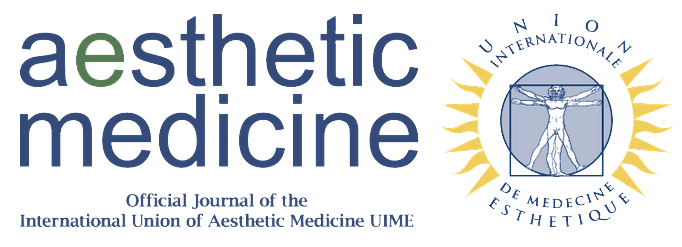Safety and Efficacy of Filler Injections in Patients with Immune-Mediated Inflammatory Diseases
Keywords:
Hyaluronic Acid Fillers, Immune-Mediated Inflammatory Diseases, Prospective Observational Study, Safety and Efficacy, Accelerated Filler DegradationAbstract
Background: Dermal fillers, particularly hyaluronic acid (HA) fillers, are commonly used in aesthetic medicine. However, their safety and efficacy in patients with immune-mediated inflammatory diseases (IMIDs) require further study. Aim: This study aims to evaluate the safety and efficacy of HA fillers in IMID patients over a five-year follow-up period. Methods: A prospective observational study was conducted in Milan, enrolling 170 patients with IMIDs who received HA fillers at least twice per year. Clinical assessments focused on adverse reactions, flare-ups, and the durability of HA fillers in an inflammatory environment. Results: No significant adverse reactions or IMID flare-ups were observed at six months, with significant improvements in quality of life (Delta DLQI, p < 0.001). However, flare-ups were observed in a small number of patients over time, with an increased frequency of filler applications due to the accelerated degradation of HA. Conclusions: HA fillers are safe to use in IMID patients in remission, offering aesthetic and functional benefits. However, the accelerated degradation of HA in this population warrants more frequent treatments. Further large-scale studies are needed to refine clinical guidelines.
References
1. Funt D, Pavicic T. Dermal fillers in aesthetics: an overview of adverse events and treatment approaches. Clin Cosmet Investig Dermatol. 2013; 6:295-316.
2. Creadore A, Watchmaker J, Maymone MBC, Pappas L, Vashi NA, Lam C. Cosmetic treatment in patients with autoimmune connective tissue diseases: Best practices for patients with lupus erythematosus. J Am Acad Dermatol. 2020; 83(2):343-363.
3. Decates TS, Velthuis PJ, Schelke LW, et al. Increased risk of late-onset, immune-mediated, adverse reactions related to dermal fillers in patients bearing HLA-B*08 and DRB1*03 haplotypes. Dermatol Ther. 2021; 34(1):e14644.
4. Davidson A, Diamond B. Autoimmune diseases. N Engl J Med. 2001; 345(5):340-350.
5. Koren A, Sarbagil-Maman H, Litinsky I, Furer V, Artzi O. Dermal filler injections in patients with autoimmune and inflammatory rheumatic diseases-The patients' perspective. Dermatol Surg. 2022; 48(1):82-86
6. Cumsky HJL, Pham MM, Hoss E. Use of botulinum toxin and hyaluronic acid filler to treat oral involvement in scleroderma. Dermatol Surg. 2022; 48(6):698-699.
7. Sharad J. Hyaluronic acid filler injection for localized scleroderma - Case report and review of literature on filler injections for localized scleroderma. Clin Cosmet Investig Dermatol. 2022; 15:1627-1637.
8. Pirrello R, Verro B, Grasso G, et al. Hyaluronic acid and platelet-rich plasma, a new therapeutic alternative for scleroderma patients: a prospective open-label study. Arthritis Res Ther. 2019; 21(1):286.
9. Owczarczyk-Saczonek A, Zdanowska N, Wygonowska E, Placek W. The Immunogenicity of hyaluronic fillers and its consequences. Clin Cosmet Investig Dermatol. 2021; 14:921-934
10. Kwak SS, Yoon KH, Kwon JH, et al. Comparative analysis of hyaluronidase-mediated degradation among seven hyaluronic acid fillers in hairless mice. Clin Cosmet Investig Dermatol. 2021; 14:241-248.
11. Kubik P, Gallo D, Tanda ML, et al. Evaluation of the safety of Neauvia Stimulate injectable product in patients with autoimmune thyroid diseases based on histopathological examinations and retrospective analysis of medical records. Gels. 2023; 9(6):440.
12. Owczarczyk-Saczonek A, De Boulle K. Hyaluronic acid fillers and ASIA syndrome: case studies. Clin Cosmet Investig Dermatol. 2023; 16:2763-2771. Erratum in: Hyaluronic acid fillers and ASIA syndrome: case studies [Erratum]. Clin Cosmet Investig Dermatol. 2023; 16:3321-3322.
Downloads
Published
Issue
Section
License
Copyright (c) 2025 Sara Di Gregorio, Giovanni Damiani

This work is licensed under a Creative Commons Attribution-NonCommercial 4.0 International License.
This is an Open Access article distributed under the terms of the Creative Commons Attribution License (https://creativecommons.org/licenses/by-nc/4.0) which permits unrestricted use, distribution, and reproduction in any medium, provided the original work is properly cited.
Transfer of Copyright and Permission to Reproduce Parts of Published Papers.
Authors retain the copyright for their published work. No formal permission will be required to reproduce parts (tables or illustrations) of published papers, provided the source is quoted appropriately and reproduction has no commercial intent. Reproductions with commercial intent will require written permission and payment of royalties.

This work is licensed under a Creative Commons Attribution-NonCommercial 4.0 International License.





